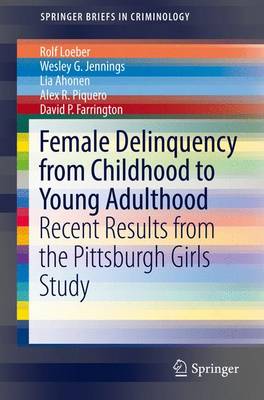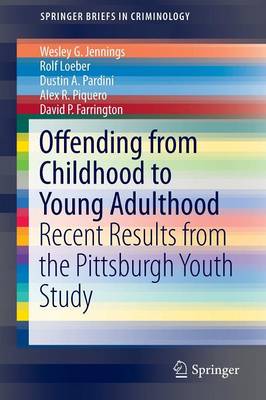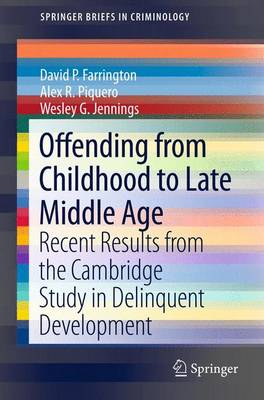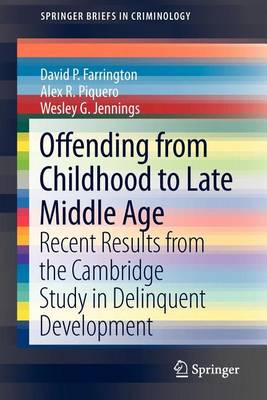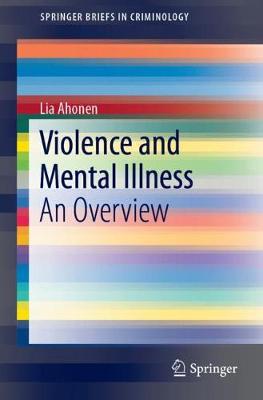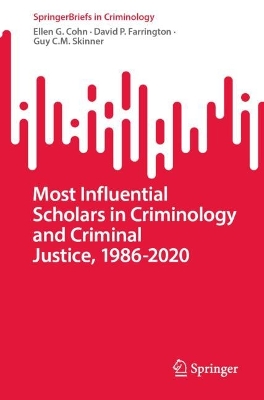SpringerBriefs in Criminology
7 total works
Female Delinquency From Childhood To Young Adulthood
by Rolf Loeber, Wesley G. Jennings, Lia Ahonen, Alex R. Piquero, and David P. Farrington
In five chapters, this short volume reviews the limited extent of girls' delinquency literature, presents data on girls' offending patterns (onset, persistence, specialization, and desistence), provides insights on gender differences by comparison with the Pittsburgh Youth Study, which focused on male offenders, and explores the theoretical and practical implications of the results.
By understanding the origins and onset of criminal behavior in girls, researchers can begin to understand effective interventions and crime prevention. This Brief will be of interest to researchers in criminology and criminal justice, as well as related fields such as sociology, public policy, and psychology.
Offending from Childhood to Young Adulthood
by Wesley G. Jennings, Rolf Loeber, Dustin A. Pardini, Alex R. Piquero, and David P. Farrington
This Brief examines criminal careers by providing the most extensive and comprehensive investigation to date on the official offending, self-reported offending, and trajectories of offending of the Pittsburgh Youth Study (PYS) participants. The PYS is a longitudinal study, which was initiated in 1987, and involves repeated follow-ups on several community cohorts (starting in grades 1, 4, and 7) of inner-city boys in Pittsburgh, Pennsylvania. This Brief covers the Youngest and Oldest PYS cohorts (which had the most follow-up and most data available) from ages 10-30. It provides the most complete descriptive analyses of the criminal careers of these males to date.
The three cohorts are commonly referred to as the Youngest, Middle, and Oldest cohorts, respectively. Consistent with several prior publications with the PYS data (Loeber et al., 2008), this book focuses only on data from the Youngest and Oldest cohorts as these cohorts were followed up the most frequently and have the longest time window of data available.
It will be of interest to researchers in Criminology and Criminal Justice, as well as related fields like Sociology, Developmental Psychology, Social Policy, and Education.
Offending from Childhood to Late Middle Age
by David P. Farrington, Alex R. Piquero, and Wesley G. Jennings
Offending from Childhood to Late Middle Age is a timely volume by leading researchers in Life Course Criminology, which reports new findings from The Cambridge Study in Delinquent Development, a prospective longitudinal survey of 411 South London males first studied at age 8 in 1961. The main aim of the study is to advance knowledge about criminal careers up to age 56.
At the time of these most recent findings, forty-two percent of the males were convicted, with an average ten-year conviction career. Only seven percent of the males accounted for half of all convictions. Almost all of the males (93 percent) reported committing an offense in four age ranges, compared with 29 percent who were convicted at these ages. There were on average of 39 self-reported offenses per conviction. Group-based trajectory analyses indicated that, while there were distinct groups of offenders who followed different age-crime trajectories between ages 10 and 56, five groups best characterized the criminal careers of the men, with two groups, high adolescence peak and high rate chronic, exhibiting the most offending. Also, the offending trajectories were predicted by individual and environmental childhood risk factors, with the most chronic offenders (to age 56) having the most extreme scores on childhood risk. Based on these results, risk assessment instruments could be developed and risk-focused prevention could be implemented in early childhood, including parent training, pre-school intellectual enrichment programs and home visiting programs, in order to prevent chronic styles of offending from being initiated.
This work will be of interest to researchers in criminology and criminal justice, especially those with an interest in life course criminology and crime prevention, while also being of use as a research framework for other studies. It will also be of interest to researchers in sociology, psychology, and other social sciences, as well as policy makers and practitioners.
"This is a 'must read' for anyone seeking to understand the development and course of crime from childhood through adulthood. Comparative analyses of officially recorded and self-reported offending and analyses of the predictive power of childhood risks to distinguish offending trajectories are important contributions of this new milestone in the Cambridge Study in Delinquent Development."
J. David Hawkins, Ph.D., Endowed Professor of Prevention, Social Development Research Group, School of Social Work, University of Washington
"For more than four decades the Cambridge Study of Delinquent Development has been a guiding light for research on what has come to be called developmental criminology. This latest installment is still another demonstration of the importance of this seminal study."
Daniel S. Nagin, Teresa and H. John Heinz III University Professor of Public Policy and Statistics, Carnegie Mellon University
Taking into account differences between youth and adults, as well as gender and racial difference, this innovative volume will be useful to policy-makers, legislators, researchers and students interested in addressing the growing public concern about mentally ill individuals at risk for violence.
Most Influential Scholars in Criminology and Criminal Justice, 1986-2020
by Ellen G. Cohn, David P. Farrington, and Guy C.M. Skinner
This brief examines the influence and prestige of scholars and works in the field of criminology and criminal justice, as well as changes in influence and prestige over a period of 35 years, using citation analysis. Based on responses to prior research, most criminologists consider the results both fascinating and thought-provoking, although methods of measuring scholarly influence are also highly controversial. The brief includes 35 years of data (1986 through 2020) on the most-cited scholars and works in major American and international criminology and criminal justice journals, and provides an objective measure of scholarly influence and prestige. Appropriate for graduate students and researchers, it helps to document the intellectual development of criminology and criminal justice as a field of study.
Understanding and Preventing Recidivism of Young Offenders in Argentina
by Mirian Susana Orlando and David P. Farrington
This book aims to advance knowledge about the recidivism of young offenders. It reviews knowledge about risk factors for recidivism and about protective factors that encourage desistance. It then reviews quantitative research on predictors of recidivism versus desistance of young offenders in Buenos Aires, Argentina, based on following up over 100 young offenders during a two-year statutory monitoring period. Numerous factors are identified that predict recidivism: family, educational, social, community, demographic, offence history, substance use history. It then presents qualitative research based on offenders’ narratives, using extensive verbatim quotations, that explain their recidivism versus desistance. Finally, it reviews research on the prevention of recidivism of young offenders and makes recommendations based on the quantitative and qualitative analyses. This book should be of great interest to all academics, researchers, practitioners and policy makers who are interested in juvenile offending and recidivism, including criminologists, psychologists, psychiatrists, social scientists and criminal justice practitioners.
